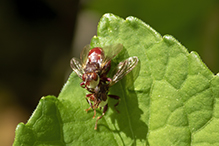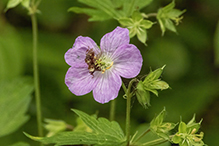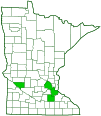Thick-headed fly
(Myopa clausa)
Conservation • Description • Habitat • Ecology • Distribution • Taxonomy
Conservation Status |
|||
| IUCN Red List | not listed |
||
| NatureServe | not listed |
||
| Minnesota | not listed |
||
Description
Myopa is a genus of parasitic thick-headed flies (family Conopidae). They parasitize western honey bees, miner bees (Andrena spp.), and digger bees (Anthophora spp.). There are at least 31 currently recognized species of Myopa worldwide, at least 4 in Minnesota. Four species make up what is called the “curticornis complex”. Morphological features of these four intergrade, making identification to species level difficult. However, Myopa clausa is the only one of the four that occurs east of the Rocky Mountains.
Myopa clausa is a reddish, brightly colored, medium-sized, thick-headed fly. The adult is ¼″ to ⅜″ (7 to 9 mm) in length.
The head is thick. There is a large compound eye on each side of the head and three small simple eyes (ocelli) in a triangle on the top of the head. The compound eyes do not meet at the top of the head on eithe sex. The cheeks are as wide as the compound eye is high. The protruding mouthpart (proboscis) is usually long but may be quite short. It is bent at a sharp angle in the middle. The second segment is often nearly as long as the third segment (femur) of the hind leg. The antennae have three segments. The first segment is very short. The second segment is disctinctly longer than the third. The third segment is lighter than the first two and has a forward-pointing bristle (arista) in the middle. The arista is bare, not feather-like (plumose).
The abdomen is narrowed at the base. It is long and spherical, especially on the male. It is reddish, shiny, and sparsely covered with short black hairs. There is a pale, semi-circular spot on each side of segments 2 and 3, and pale, powdery (pollinose) markings on segments 4 and 5. The pollinose markings are distinct on the female, less distinct on the male, especially on the fifth segment.
The wing is clear or lightly tinged with brown but is otherwise unmarked. The radial-media (r-m) cross vein is not thickened. There is no spurious vein between the radius (R) and media (M) veins. The first posterior cell is closed. The anal cell (Cu) is much longer than the second basal cell (M).
Size
Total length: ¼″ to ⅜″ (7 to 9 mm)
Similar Species
Habitat
Ecology
Season
One generation per year:
Behavior
Adults perch on the lowest twigs of shrubs, on grass stems, and on flowers, usually no more than 16″ above the ground. They are active in sunny conditions, inactive when cloudy or overcast.
Males aggregate on hilltops and wait for a female to fly there and copulate with them.
Life Cycle
The female pounces on a host bee while in flight. She inserts her ovipositor between two abdominal segments, inserts a single egg, and flies away. The entire process takes a very short time. The larva feeds within the abdominal cavity, eventually killing the host. The adult fly emerges from the abdomen of the dead host.
Larva Food/Hosts
Western honey bee (Apis mellifera), miner bees (Andrena spp.), and digger bees (Anthophora spp.)
Adult Food
Distribution |
||
|
Sources |
|
| 10/5/2025 | ||
Occurrence |
||
|
||
Taxonomy
Order
Suborder
Brachycera
Infraorder
Cyclorrhapha
Zoosection
Schizophora
Zoosubsection
Acalyptratae (acalyptrate flies)
Superfamily
Sciomyzoidea (kelp, marsh, thick-headed flies and allies)
Family
Conopidae (thick-headed flies)
Subfamily
Myopinae
Tribe
Myopini
Genus
Myopa
Subordinate Taxa
Synonyms
Common Names
This species has no common name. The common name of the family Conopidae is thick-headed flies, and it is applied here for convenience.
Glossary
Arista
A large bristle on the upper side of the third segment of the antenna of a fly. Plural: aristae.
Femur
On insects and arachnids, the third, largest, most robust segment of the leg, coming immediately before the tibia. On humans, the thigh bone.
Ocellus
Simple eye; an eye with a single lens. Plural: ocelli.
Proboscis
The protruding, tubular mouthpart of a sucking insect.
Visitor Photos
Share your photo of this insect.
This button not working for you?
Simply email us at info@MinnesotaSeasons.com.
Attach one or more photos and, if you like, a caption.
Greg Watson |
||
 |
 |
|
I was hiking in Eagles Bluff City Park in La Crescent, MN and I spotted these flies mating. The best I can determine while searching the Internet is that they are “red and white big headed fly”. I found just one mention of them at Bugguide.net. I’m interested in finding out more about them and thought that maybe you would like to include them in your list. |
I was hiking in Vetsch Park, here in La Crescent, and came across another pair of them. |
|
MinnesotaSeasons.com Photos
|
|

Slideshows

Visitor Videos
Share your video of this insect.
This button not working for you?
Simply email us at info@MinnesotaSeasons.com.
Attach a video, a YouTube link, or a cloud storage link.
Other Videos

Visitor Sightings
Report a sighting of this insect.
This button not working for you?
Simply email us at info@MinnesotaSeasons.com.
Be sure to include a location.
Greg Watson
5/24/2021
Location: Vetsch Park, La Crescent MN
I was hiking in Vetsch Park, here in La Crescent, and came across another pair of them.
Greg Watson
5/17/2021
Location: Eagles Bluff City Park, La Crescent, MN
I was hiking in Eagles Bluff City Park in La Crescent, MN and I spotted these flies mating. The best I can determine while searching the Internet is that they are “red and white big headed fly”. I found just one mention of them at Bugguide.net.
I’m interested in finding out more about them and thought that maybe you would like to include them in your list.
Minnesota Seasons Sightings



